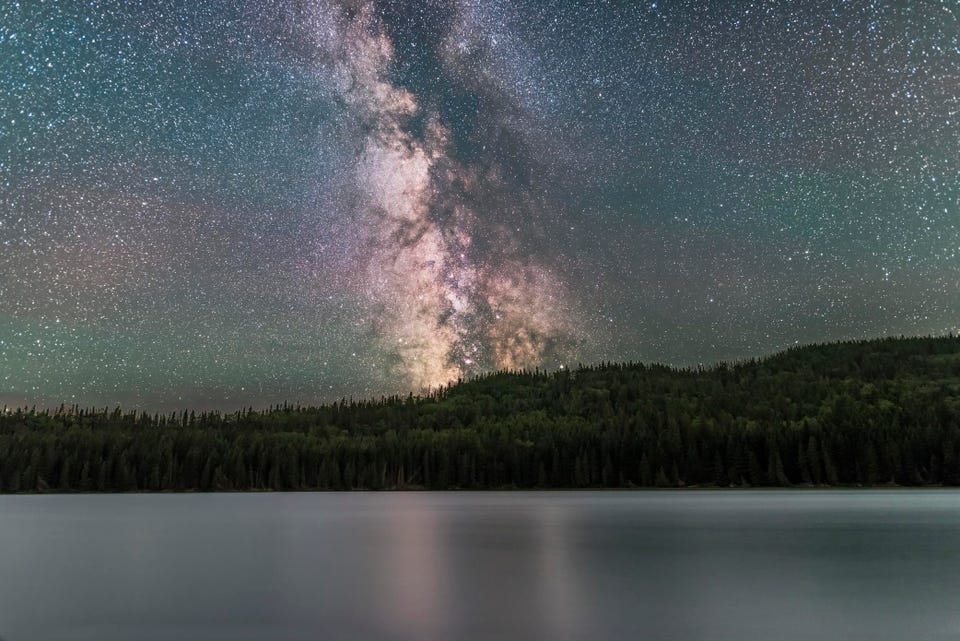Science Why Is The Milky Way Wobbling? How Cosmic Ripples Reveal An Ancient Galactic Collision Ripping Apart An Iconic Constellation Jamie Carter Senior Contributor Opinions expressed by Forbes Contributors are their own. I inspire people to go stargazing, watch the Moon, enjoy the night sky Following New! Follow this author to stay notified about their latest stories. Got it! Oct 25, 2022, 08:00pm EDT | New! Click on the conversation bubble to join the conversation Got it! Share to Facebook Share to Twitter Share to Linkedin The summer southern Milky Way over Reesor Lake in Cypress Hills Interprovincial Park, a Dark Sky .
. . [+] Preserve Only July 28/29, 2017, just after moonset with Sagittarius in the southwest, and Saturn just about to go behind the treeline Wind rippled the water and prevented a reflection of stars and the Milky Way Some airglow tints the sky This is a composite of four untracked exposures for the ground mean combined to smooth noise and four tracked exposures for the sky taken immediately afterwards again, mean combined to smooth noise The ground shots were 2 minutes each at f/28 and ISO 3200, The sky shots were 1 minute each at f/2 and ISO 1600 All with the 20mm Sigma Art lens and Nikon D750 The tracker was the Star Adventurer Mini.
(Photo by: VW Pics/Universal Images Group via Getty Images) Universal Images Group via Getty Images It’s Milky Way season. If you ever wanted to see the arc of our galaxy stretching across the night sky, get yourself to a dark sky destination away from light pollution in the next couple of weeks and you’ll get a great view as soon as it gets dark. You’ll see stars and you’ll see dark patches of gas and dust within it, but what you won’t see a large parts of the Milky Way’s outer disk rippling and vibrating.
And yet they are, according to a new paper published in Monthly Notices of the Royal Astronomical Society , and all because of a dwarf galaxy in the constellation of Sagittarius that shook the Milky Way hundreds of millions of years ago. Sagittarius is a fabulous constellation to study with binoculars or a small telescope. It’s the location of the Galactic Center and it’s home to dense starfields, nebulae and much more.
It’s best seen in summer from the northern hemisphere. Using data from the Gaia satellite—a groundbreaking European Space Agency (ESA) mission to create a precise 3D map of more than a thousand million stars throughout our Milky Way—a team led by researchers at Lund University in Sweden were able to study the strength of the ripples and so piece together the history of Sagittarius’ orbit around the Milky Way. This new image from the Hubble Space Telescope shows a small galaxy called the Sagittarius dwarf .
. . [+] irregular galaxy, or “SagDIG” for short.
SagDIG is relatively nearby, and Hubble’s sharp vision is able to reveal many thousands of individual stars within the galaxy. NASA, ESA, and The Hubble Herita MORE FOR YOU They Inherited Billions Upon Billions: Meet America’s Richest Heirs Biden Administration Wants To Make It Easier To Seize Crypto Without Criminal Charges Andrew Kwon: The Bridal Designer You Need To Know Now “We can see that these stars wobble and move up and down at different speeds,” said Paul McMillan, an astronomy researcher at Lund Observatory who led the study. “When the dwarf galaxy Sagittarius passed the Milky Way, it created wave motions in our galaxy, a little bit like when a stone is dropped into a pond.
” Sagittarius is gradually being torn apart, but a couple billion years ago it was much larger and possibly accounted for a fifth of the mass of the entire Milky Way. “We can [now] study the Milky Way in the same way that geologists draw conclusions about the structure of the Earth from the seismic waves that travel through it,” said McMillan. “This type of “galactic seismology” will teach us a lot about our home galaxy and its evolution.
” Gaia is changing astronomy. Since it launched almost a decade ago it’s measured the movement across the sky of approximately two billion stars. It’a slo measured the movement towards or away from us of 33 million stars.
With this data astronomers are able to see where stars are headed and where they’ve come from. Wishing you clear skies and wide eyes. Follow me on Twitter or LinkedIn .
Check out my website or some of my other work here . Jamie Carter Editorial Standards Print Reprints & Permissions.
From: forbes
URL: https://www.forbes.com/sites/jamiecartereurope/2022/10/25/why-is-the-milky-way-wobbling-how-cosmic-ripples-reveal-an-ancient-galactic-collision-ripping-apart-an-iconic-constellation/



